Processes for improving high aspect ratio cellulose filament blends
a technology of cellulose filament and high aspect ratio, which is applied in the field of improving high aspect ratio cellulose filament and blend, can solve the problems of limited length and aspect ratio, cellulose fibers have to be cut inevitably, and the application of high aspect ratio particles in papermaking is not developed, so as to achieve the effect of reducing the particle level and high aspect ratio
- Summary
- Abstract
- Description
- Claims
- Application Information
AI Technical Summary
Benefits of technology
Problems solved by technology
Method used
Image
Examples
example 1
[0072]Cellulose nano-filaments (CNF) were obtained. The CNF were made from bleached softwood Kraft pulp according to the process of making CNF disclosed in Hua et al. (U.S. Pat. No. 9,856,607B2 or U.S. Patent Application Publication 2015 / 0275433A1). The CNF blend was received as an aqueous suspension having a consistency of 31.4% solids. The provided CNF blend was diluted with stirring with water at 80° to a consistency of 1.2%. The pH of the 1.2% dilution of CNF was then lowered to a pH of 4.0 and stirred for two hours. The pH of that dilution was then raised to a pH of 11. Sufficient material was set aside for production of hand sheet as a control material.
[0073]The high pH dilution of the CNF blend was then centrifuged and the low-solids (liquid) fraction was decanted off the sample leaving the high-solids fraction for collection. The remaining solid from the first dilution / fractionation / collection cycle, containing fraction was again diluted to 1.2% at a pH of 11 and stirred, an...
PUM
| Property | Measurement | Unit |
|---|---|---|
| Length | aaaaa | aaaaa |
| Fraction | aaaaa | aaaaa |
| Length | aaaaa | aaaaa |
Abstract
Description
Claims
Application Information
 Login to View More
Login to View More - R&D
- Intellectual Property
- Life Sciences
- Materials
- Tech Scout
- Unparalleled Data Quality
- Higher Quality Content
- 60% Fewer Hallucinations
Browse by: Latest US Patents, China's latest patents, Technical Efficacy Thesaurus, Application Domain, Technology Topic, Popular Technical Reports.
© 2025 PatSnap. All rights reserved.Legal|Privacy policy|Modern Slavery Act Transparency Statement|Sitemap|About US| Contact US: help@patsnap.com


